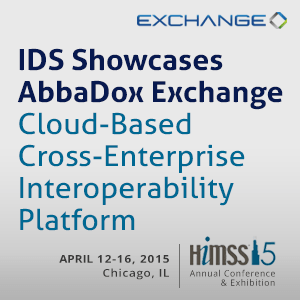Shares Information Across Disparate EHR Systems
FORT LAUDERDALE, FL – April 10, 2015 – IDS will showcase at HIMSS 2015 its cloud-based AbbaDox Exchange interoperability platform, which facilitates data sharing and viewing across disparate electronic health record (EHR) and other IT systems, while automating processes and workflow.
“The scalable technology platform offers strategic, tactical and transformative benefits by connecting on-premise clinical and administrative operations to a cloud environment,” explains Yaniv Dagan, CEO of IDS. “By enabling this connectivity, it facilitates the collection, management, storage and transmission of structured and unstructured data for coordination and transition of care, improving population health management.”
The platform enhances each site’s native IT infrastructure, translating data as required, and also provides a unique presentation layer with data viewing and collaboration tools. It is the choice for healthcare delivery organizations, accountable care organizations (ACOs), health information exchanges (HIEs), and multi-site hospitals to eliminate healthcare IT incompatibilities and efficiently exchange patient information in real time. It also can be employed in a similar capacity for payer organizations.
AbbaDox Exchange takes the burden of system integration out of the healthcare enterprise, enabling rapid deployment and ease-of-use through platform-as-a-service (PaaS) and middleware architecture, eliminating VPNs and other point-to-point connections. The technology takes advantage of such industry standards as HL7, Continuity of Care Document (CCD) files, and the emerging Direct email standard to automatically transmit data to a desired site. Cloud deployment of the technology delivers the benefits of standardized IT building blocks and procedures, enabling full automation and the cost-savings of an economy of scale. It also removes system maintenance and data archiving responsibilities from the healthcare provider, while building in flexibility and a focus on better patient care.
“AbbaDox Exchange can share patient information. Its unique clinical data repository allows users to access and view any type of health information, including office visit notes, discharge summaries, lab results, DICOM images, and other electronic health records. It also offers convenient collaboration and sharing tools to providers without compromising data security and integrity. Users continually stress its benefits for the coordination and transition of care required in managing patient populations,” notes Dagan. The platform provides interoperability and unlimited real-time data exchange to all authorized users wherever located. Customers can select robust, fully integrated modular components that meet their needs.
“Shifting from a fee-for-service to a value-based reimbursement model is a monumental change and poses tremendous challenges,” says Dagan. “Accurate and timely patient data sharing across providers and payers, along with intuitive workflows and collaboration tools, is key to containing costs under a fixed reimbursement structure. Through our time-tested, cost-effective technologies, AbbaDox Exchange provides much-needed, practical solutions to the realities of today’s healthcare environment.”
Dagan points out several of AbbaDox Exchange’s key technical benefits. Through HL7 mapping, the platform delivers consistent and reliable data exchange with minimal exception, enabling accurate, meaningful data. It also reconciles enterprise variables in nomenclature definitions and formatting for patient IDs/MRNs, accession numbers, referring IDs, exam codes, taxonomies and more. The technology supports claims and claim line feed (CCLF) data. It also incorporates a range of additional advanced features that speed data flow, while adding reliability, scalability and security.
AbbaDox Exchange automatically transmits a full range of data, including clinical summaries and reports, links to medical images, lab reports, patient visit status updates and complete patient EHR files. After acquisition, the subscribing facility’s information transparently flows to the AbbaDox cloud platform. Based on information in the files, it is then transformed as required for the recipient’s system and forwarded. After viewing, the EHR-ready communication can be saved in IDS’s cloud-based clinical data repository or an onsite archive compatible with the referrer’s EHR or other IT system.







